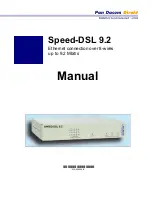
Q-Flex Satellite Modem Installation and Operating Handbook
6-84
Figure 6-40 IP Throughput Graph
QoS (traffic shaping) graphs are described in
Section 7.8.9
.
An example ACM graph is shown in
Figure 6-41
. This shows the minimum, average and
maximum terrestrial data rate over the selected time period. Note that this graph shows
how the terrestrial data rate varies over time in direct relation to dynamic changes of
modcod based on a varying Es/No from the remote modem. It does not show actual IP
throughput (which is available on the other IP throughput graphs). The ACM graph
therefore shows the actual bandwidth available over time, which can be used to
determine the benefit of using ACM, particularly when viewed over longer time periods
where the effects of short-term fluctuations are removed.
By viewing the ACM graph over a long time period such as a month, an average available
bandwidth figure is produced that can be factored into new or revised service level
agreements that incorporate the benefits of ACM when compared to the nominal data
rate of the link without ACM.
An example of the ACM graph viewed over a shorter time period is shown in
Figure 6-42
.
It is possible to put ACM into a monitor mode where the ACM graph logs what the
terrestrial data rate would be for the prevailing conditions, without ever actually changing
the modcod. This is useful for assessing the potential benefit of ACM on an existing link
without disrupting the current service in any way, or for evaluating ACM in a
representative test scenario prior to deployment (see
Section 6.2.2.7
).
















































